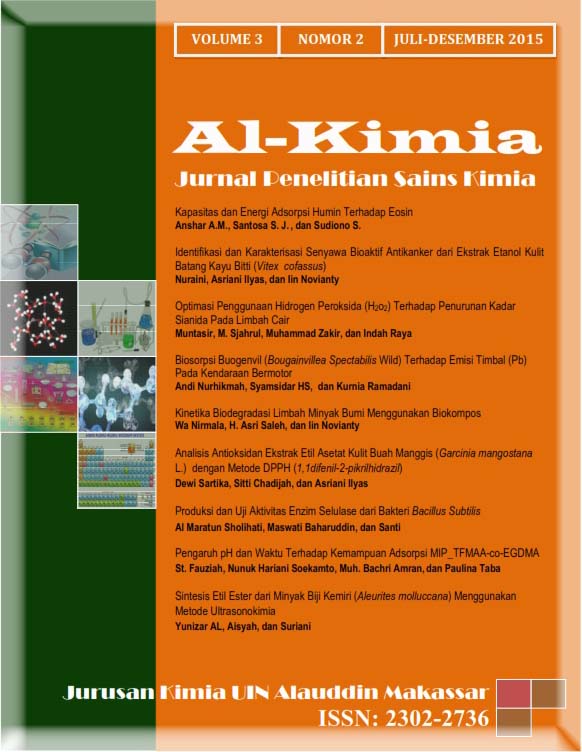Kapasitas dan Energi Adsorpsi Humin Terhadap Eosin
Abstrak
Humin is a natural ingredient that is widely available in Indonesia, especially Borneo. Humin is interact and absorb eosin compound that can cause environmental pollution. The interaction between eosin and humin was set on optimum time dan pH so that the humin adsorption would be optimum. This research measured the adsorption capacity and energy required to adsorp eosin on humin by performing various concentration of eosin. The amount of humin adsorption energy against eosin was 34.136 kJ/mol while the adsorption capacity was1, 611 x 10-6mol/g. This indicated that the type of interaction between humin and eosin was chemical interaction.
##plugins.generic.usageStats.downloads##
Referensi
Aiken. G. R., McKnight, D. M., Wershaw, R.L., dan Mac Charty. P, 1985 ”An Introduction to Humic Substances in Soil, Sediment and Water; Geochemistry, Isolations and Characterization”, John Wiley and Sons, New York.
Anshar, A.M.,Santosa, S.J., dan Sudiono, S., 2014, Kajian Adsorpsi Metilena Biru Pada Humin, Prosiding Seminar Nasional Geofisika, 189-193.
Anshar, A.M.,Santosa, S.J., dan Sudiono, S., 2015, Adsorption Rate Constants Of Eosin in Humin, Indonesia Chemical Act, 8 (1), 9-17.
Gaffey, S. J., Marley, N. A., dan Clark, S. B., 1996, Humic and Fulvic Acid and Organic Colloidal Matterial in Environmental (dalam Gaffney,
J. S.,et.al., 1996, Humic and Fulvic Acid ; Isolation, structure and Environmental Role) American Chemical society., Washington.
Hamdaoui, O. and Chiha, M., 2006, Removal of Methylene Blue from Aqueous Solutions by Wheat Bran, Acta Chim. 54 : 407–418.
Ishiwitari, R., 1985, Goechemistry of Humic Substances in Lake Sediments (dalam Aiken. G. R., McKnight, D. M., Wershaw, R.L., dan Mac Charty. P, 1985 ”An Introduction to Humic Substances in Soi, Sediment and Water; Geochemistry, Isolations and Characterization”), John Wiley and Sons, New York.
Kaled. H,, dan and Fawy H., A., 2011, Effect of Different Levels of Humic Acids on the Nutrient Content, Plant Growth, and Soil Properties under Conditions of Salinity, Soil & Water Res., 6, (1): 21–29.
Lawakka, I. 2005, Adsorpsi Merah Reaktif-1 Oleh Karbon Aktif Tempurung Kenari Sebagai Fungsi Waktu dan Jumlah Adsorben, skripsi tidak diterbitkan, Jurusan Kimia, FMIPA, Universitas Hasanuddin, Makassar.
Lynam, M.M., Kliduff, J. E., dan Weber Jr,W.J., 1995, Adsorption of Nitrophenol from Dillute Agues Solution, J. Chem. Educ., 72, 80-84
Mahatmanti, F. W., dan Sumarni, W.,2003, Kajian Termodinamika Penyerapan Zat Warna Indikator Metil Oranye (MO) Dalam Larutan Air Oleh Adsorben Kitosan, JSKA.Vol.VI.No.2.
Marlena, B., Mukimin, A., Susanti, E., 2012, Dekolorisasi Pewarna Reaktif Pada Air Limbah Industri Tekstil Secara Elektrokimia, Jurnal Riset Teknologi Pencegahan Pencemaran Industri, Vol.2(2).
Muna, N., 2014, Adsopsi Zat Warna Melacite Green (MG) oleh Komposit Kitosan Bentonit, Skripsi, Jurusan Kimia, Fakultas Sains dan Teknologi, Universitas Islam Negeri Sunan Kalijaga, Yogyakarta.
Razae, A., Ghaneian, M. T., Hashemian, S. J., Mousavvi, G.,Khavanin, A., Ghanizadeh, G., 2008, Decolorization of Reactive Blue 19 Dye From Tekstil Wastewater by the UV/H2O2 Process, Journal of Applied Sciences 8, Asian Network for Scientific Information.
Riyani, K., dan Setyaningtyas, T.,Pengaruh Karbon Aktif Terhadap Aktivitas Fotodegradasi Zat Warna Pada Limbah Cair Industri Tekstil Menggunakan Fotokatalis TiO2, Molekul, Vol. 6. No. 2, 113 - 122
Stevenson, F. J., 1994, Humus Chemistry, Genesis, Composition, Reactions, John Wiley and Sons, New York.
Tanasale, M.F.J.D.P., Killay, A., dan Laratmase, M.S., 2012, Kitosan dari Limbah Kulit Kepiting Rajungan (Portunus sanginolentus L.) sebagai Adsorben Zat Warna Biru Metilena, Jurnal Nature Indonesia, Vol 14. No.2, 165-171.
Authors who publish with this journal agree to the following terms:
1) Authors retain copyright and grant the journal right of first publication with the work simultaneously licensed under a Creative Commons Attribution License that allows others to share the work with an acknowledgement of the work's authorship and initial publication in this journal.
2) Authors are able to enter into separate, additional contractual arrangements for the non-exclusive distribution of the journal's published version of the work (e.g., post it to an institutional repository or publish it in a book), with an acknowledgement of its initial publication in this journal.
3)Authors are permitted and encouraged to post their work online (e.g., in institutional repositories or on their website) prior to and during the submission process, as it can lead to productive exchanges, as well as earlier and greater citation of published work (See The Effect of Open Access).


